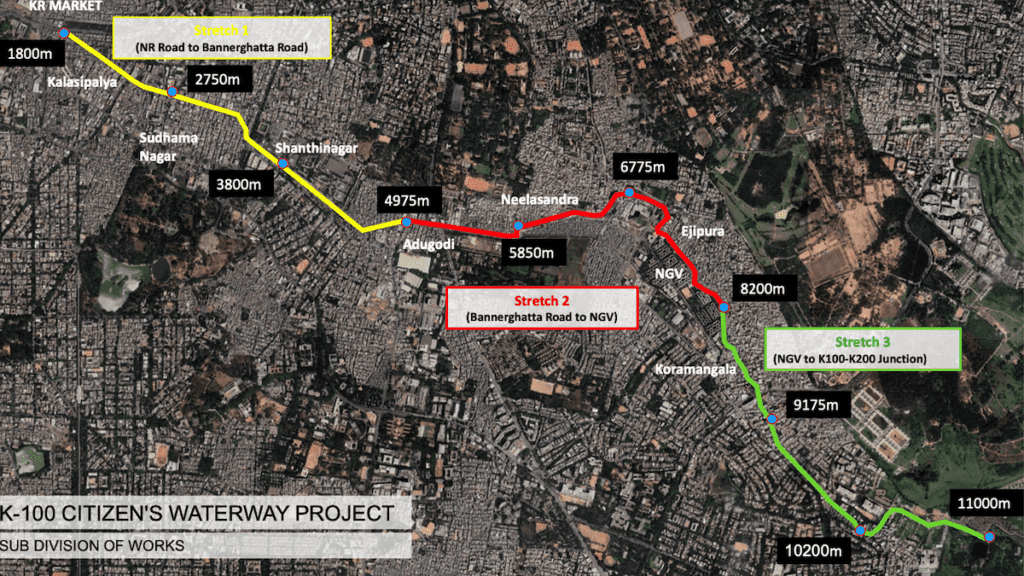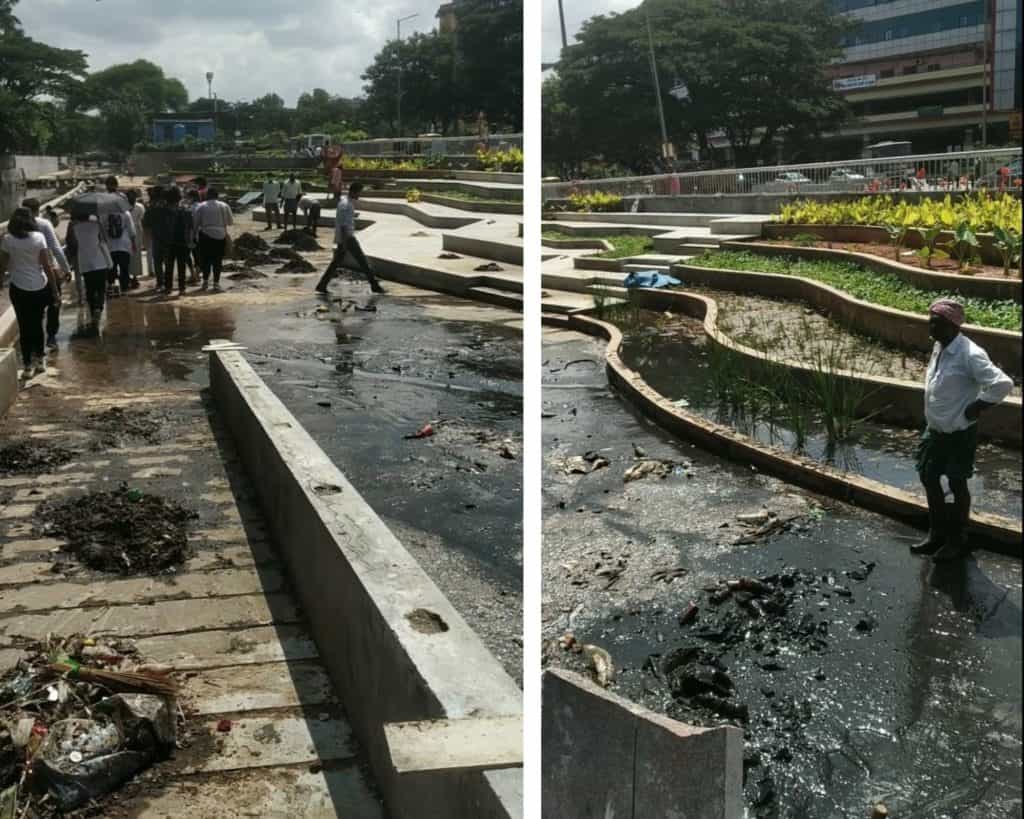‘Citizens Waterway Project,’ a part of Bengaluru Mission 2022, was launched in December 2020 by Karnataka’s Former Chief Minister B.S. Yediyurappa to upgrade the city’s infrastructure given its growing population and vehicles. ‘Citizens Waterway Project’, also known as Beautification of K-100 Rajakaluve, aims to develop the city’s storm water drains from KR market to Bellandur Lake.
But the project raises multiple questions as it does not follow the Karnataka High Court and NGT orders on the protection of Rajakaluves (major stormwater drains) and lakes of Bangalore.
Can beautification of K-100 improve the condition of the storm water drains? The proposed project is based on South Korea’s Seoul model, but will it give the same results? Several such questions will be discussed in this article.
Beautification or a Mess?
The idea of transforming Bengaluru’s storm water drains originated from South Korea’s Seoul Model of Cheonggyecheon river rejuvenation. On March 25th, 2021, Former Chief Minister B S Yediyurappa laid the foundation stone for the ambitious K-100 project ensuring the grant of Rs 175 crores under the 15th Finance Commission plan to complete the project over a period of 10 months.
Bengaluru has a 850 km storm water drain network, of which 400 km are primary storm water drains. A 11.4 km length of the primary drain has been considered for the development, from KR Market to Bellandur Lake (Shown in the picture below). As per a report in The Hindu, the project includes the following details:
- Providing and remodelling existing retaining wall at critical locations
- Construction of 5 Million Litres per Day Sewage treatment plant at Bamboo Bazaar
- Using natural material and bio-remediation techniques to improve water quality
- Creating pedestrian friendly infrastructure
- Horticultural works, including Miyawaki foresting and landscaping
- Eliminating Sewage inflow, untreated industrial effluents, dumping of garbage
As the project has been taken up by Star Infratech for execution and huge investments have been poured into the proposed infrastructure, the question arises whether it will really change the current condition of the storm water drain? Will it achieve the same results as Seoul’s model of river rejuvenation?
Read more: Citizens’ Water Way Project: How Bengaluru is revamping the Majestic-Bellandur drain network
Bangalore has a unique natural drainage system that connects to the man-made irrigation tanks (now called lakes) created during the 16th century for irrigating farmlands and to supply drinking water to the city. Rapid urbanisation hit the city by 1985, which resulted in the conversion of many lakes into apartments, bus stands, and playgrounds.
Urbanization caused not only the disappearance of lakes but encroachments further aggravated the problems of flooding in the city. This poses the question on whether the efforts that are being made to implement the European country models for the development of rajakaluve, will it actually change the condition of K-100 despite differences in the geographical, historical, and scientific context?

Design intervention of constructing retaining walls at critical sections of K-100 raises the question of why the NGT orders were not followed which state ‘Construction of Retaining wall should not result in reduction of width of the water bodies/Rajakaluves’ (Para 6 of order dated 13.08.2020). If the retaining walls are constructed, will it solve the problem of flooding? According to the research of Dr TV Ramachandra at the Indian Institute of Science (IISc), concretization affects the hydrological functional ability of storm water since it increases the velocity of water which further enhances the chances of flooding in the area.
The project also aims to construct a 5 MLD (Million Litres per Day) sewage treatment plant at Bamboo Bazaar to treat the domestic sewage, but ignores the problem of how industrial effluent will be treated, as that requires an Effluent Treatment Plant and not STP (sewage treatment plant). The project also relies on nature-based intervention to improve water quality. But if the natural material and bio-remediation techniques are to be used, it will require a specific speed of flow to treat and improve water quality. But will these techniques work in a flood situation?
Also, the initial implementation of the mock-up area at Shanti Nagar shows the problem of accumulation of silt and solid waste that indicates it will require periodic maintenance which would prohibit people access to the K-100 waterway until it gets cleaned!

Read more: 50% stormwater drains lost: Bengaluru’s flooding is no surprise
Problems of planning and governance
The encroachments in and around the buffer zones of the lakes and Rajakaluves have been a constant headache for the BBMP. Citizen’s waterway stretch from KR Market to Bellandur Lake shows massive encroachment in the primary storm water drain (Rajakaluve).

These buffer zones prescribed by the NGT are 50, 25 and 15 meters for primary, secondary, and tertiary storm water drains respectively. The Monitoring Committee was appointed in December 2018 by NGT to review the implementation of NGT orders issued in regard to the Bellandur, Varthur and Agaram Lakes. Despite NGT orders which specifies that BBMP is to survey and notify the Rajakaluves for purposes of buffer zones, the Monitoring Committee’s report of February 2021 shows (in Page 21) that BBMP has not submitted the details of such a survey to the Committee. The buffer zones for Rajakaluve have also been mentioned in the Bangalore Revised Master Plan 2031 zoning regulations.
Considering the regulations and orders by NGT on Rajakaluves, when BBMP has not submitted the details of buffer zones of Rajakaluves to NGT, has the Citizens Waterway Project received clearance? The project was not completed within the deadline of January 2022. As per a report in Deccan Herald last October, only 40% of the work had been completed at the time. When court cases related to encroachments are going on in the Karnataka High Court, when will the project get completed? Will this also not affect the project’s budget?
Is it inclusion or isolation?
The city’s storm water drains (Rajakaluve) are the lungs of the lakes. The series of lakes are interconnected by these storm water drains (Rajakaluve) where the rainwater gets captured from the respective catchment area and the surplus water then flows into interconnected lakes through Rajakaluve.
The Justice N K Patil Committee report ‘Preservation of Lakes in the City of Bangalore’ recommended that lake restoration is to be taken up based on lake series/sub-series and not in isolation, to have better results and impact. The Citizen’s Waterway Project focuses on the development of 11.4 km of primary drains, but what happens to Bengaluru’s remaining storm water drains? Do they not need the same beautification? Why select only the KR Market to Bellandur Lake storm water drain for a facelift? The technological and design interventions of such a project will lack sustainability.